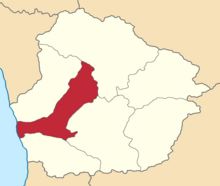Senaki Uyezd
Senaki Uyezd
Сенакский уезд | |
|---|---|
 | |
 Location in the Kutais Governorate | |
| Country | Russian Empire |
| Governorate | Kutais |
| Viceroyalty | Caucasus |
| Established | 1867 |
| Abolished | 1930 |
| Seat | Senaki |
| Uchastoks | Abasha, Nakalakevsky, Martvili, Senaki, and Nakalakev |
| Area | |
| • Total | 2,127 km2 (821 sq mi) |
| Population (1916) | |
| • Total | 159,678 |
| • Density | 75/km2 (190/sq mi) |
The Senaki Uyezd (Russian: Сенакский уезд; Georgian: სენაკის მაზრა) was a uezd (county) of the Kutais Governorate of the Caucasus Viceroyalty of the Russian Empire. It bordered the Zugdidi Uyezd to the west, the Lechkhumi Uyezd to the north, the Kutais Uyezd to the east, and the Ozurgeti Uyezd to the south. The area of the uezd corresponded to most of the contemporary Samegrelo-Zemo Svaneti region of Georgia. The Senaki Uyezd was eponymously named for its administrative center, Senaki.[1]
History[]
The Senaki Uyezd was formed in 1846 as part of the Kutaisi Governorate on the territory of the historical region of Samegrelo during the time of the Russian Empire.
In 1918, the Kutaisi Governorate including the Senaki Uyezd was incorporated into part of the Georgian Democratic Republic.[1]
Administrative divisions[]
The uchastoks (sub-counties) of the Senaki Uyezd were:[2]
- Abasha (Абашский участок)
- Bandzinsky (Бандзинский участок)
- Martvili (Мартвильский участок)
- Senaki (Сенакский участок)
- Nakalakevsky (Накалевский участок)
Demographics[]
Russian Imperial Census of 1897[]
According to the 1897 Russian Empire Census, the population of the Senaki Uyezd was 115,785, with 1,248 living in the administrative capital Senaki, and 7,346 in the city of Poti. The ethnic composition of the county according to the 1897 census was the following:[3]
| Ethnic group | Senaki | |
|---|---|---|
| Georgian | 14,338 | 12.4% |
| Mingrelian | 96,851 | 83.7% |
| Russian | 1,395 | 1.2% |
| Georgian-Jew | 448 | 0.4% |
| Armenian | 448 | 0.4% |
| Greek | 401 | 0.4% |
| TOTAL | 115,785 | 100.0% |
Caucasian Calendar of 1917[]
The 1917 Caucasian Calendar which produced statistics of 1916 indicates 159,678 residents in the Senaki Uyezd, including 86,448 men and 73,230 women, 149,112 of whom were the permanent population, and 10,566 were temporary residents:[4]
| Ethnic group | Poti | Rural | TOTAL | |
|---|---|---|---|---|
| Georgians | 12,441 | 139,303 | 151,744 | 95.0% |
| Russians | 2,836 | 4 | 2,840 | 1.8% |
| Jews | 847 | 1,639 | 2,486 | 1.6% |
| Armenians | 1,529 | 0 | 1,529 | 1.0% |
| Asiatic Christians | 769 | 0 | 769 | 0.5% |
| Other Europeans | 239 | 0 | 239 | 0.1% |
| TOTAL | 18,731 | 140,947 | 159,678 | 100.0% |
References[]
- ^ a b Tsutsiev, Arthur (2014). Atlas of the Ethno-Political History of the Caucasus. Translated by Nora Seligman Favorov. New Haven: Yale University Press. ISBN 9780300153088.
- ^ Кавказский календарь .... на 1913 год (in Russian). Tiflis: Office of the Viceroy of the Caucasus. 1913. pp. 271–317.
- ^ Первая всеобщая перепись населения Российской Империи 1897 г. Распределение населения по родному языку. Кутаисский уезд
- ^ Кавказский календарь .... на 1917 год (in Russian). Tiflis: Office of the Viceroy of the Caucasus. 1917. pp. 349–378.
- Georgia (country) history stubs
- Caucasus stubs
- Russia stubs
- Uyezds of Kutais Governorate
